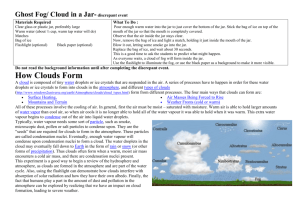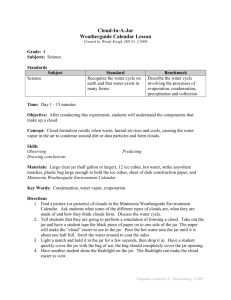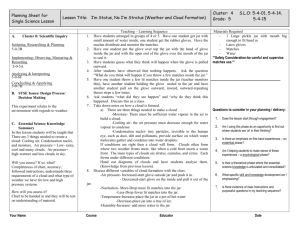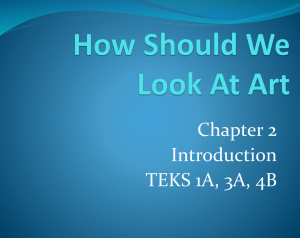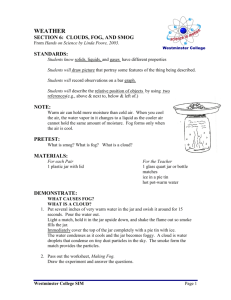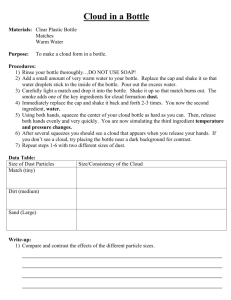“Ghost Fog” or “Cloud in a Jar”
advertisement
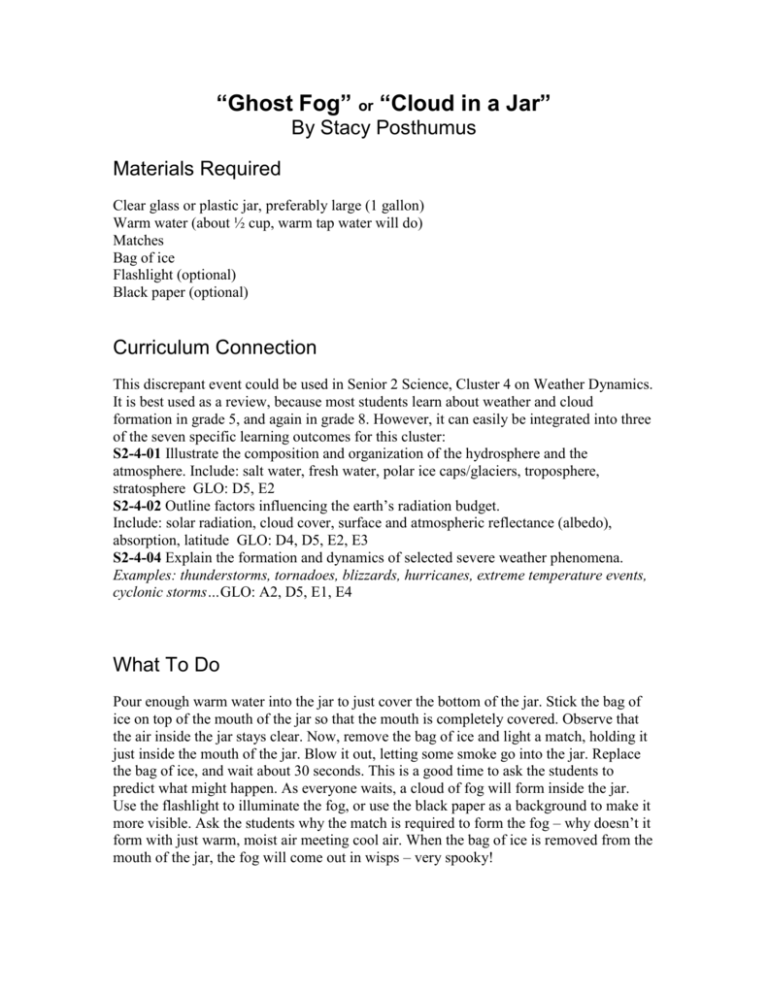
“Ghost Fog” or “Cloud in a Jar” By Stacy Posthumus Materials Required Clear glass or plastic jar, preferably large (1 gallon) Warm water (about ½ cup, warm tap water will do) Matches Bag of ice Flashlight (optional) Black paper (optional) Curriculum Connection This discrepant event could be used in Senior 2 Science, Cluster 4 on Weather Dynamics. It is best used as a review, because most students learn about weather and cloud formation in grade 5, and again in grade 8. However, it can easily be integrated into three of the seven specific learning outcomes for this cluster: S2-4-01 Illustrate the composition and organization of the hydrosphere and the atmosphere. Include: salt water, fresh water, polar ice caps/glaciers, troposphere, stratosphere GLO: D5, E2 S2-4-02 Outline factors influencing the earth’s radiation budget. Include: solar radiation, cloud cover, surface and atmospheric reflectance (albedo), absorption, latitude GLO: D4, D5, E2, E3 S2-4-04 Explain the formation and dynamics of selected severe weather phenomena. Examples: thunderstorms, tornadoes, blizzards, hurricanes, extreme temperature events, cyclonic storms…GLO: A2, D5, E1, E4 What To Do Pour enough warm water into the jar to just cover the bottom of the jar. Stick the bag of ice on top of the mouth of the jar so that the mouth is completely covered. Observe that the air inside the jar stays clear. Now, remove the bag of ice and light a match, holding it just inside the mouth of the jar. Blow it out, letting some smoke go into the jar. Replace the bag of ice, and wait about 30 seconds. This is a good time to ask the students to predict what might happen. As everyone waits, a cloud of fog will form inside the jar. Use the flashlight to illuminate the fog, or use the black paper as a background to make it more visible. Ask the students why the match is required to form the fog – why doesn’t it form with just warm, moist air meeting cool air. When the bag of ice is removed from the mouth of the jar, the fog will come out in wisps – very spooky! Theoretical Background Clouds require certain conditions to form. In general, first the air must be moist – saturated with moisture, in fact. However, this alone will not form clouds unless there is something in the air for the water vapor to condense onto – smoke, microscopic dust, or salt particles are “seeds” that are required for clouds to form in the atmosphere. This particulate matter is termed “condensation nuclei” because it forms the nucleus of a water droplet. Thus clouds often form when a warm, moist air mass encounters a cold air mass, and there are condensation nuclei present. This is basically what we have reproduced on a small scale inside the jar: warm moist air (warm water in bottom), cool air above (air near the ice pack), and condensation nuclei (smoke from the match). Another way that clouds form is when the air pressure changes dramatically in the presence of moisture and condensation nuclei – which is another way to do this experiment, using a plastic bag to control air pressure instead of ice controlling the temperature. The second way is more dramatic, but more difficult to get good results. This experiment is a good way to begin a review of the hydrosphere and atmosphere, as clouds are formed in the atmosphere and are part of the water cycle. Also, using the flashlight can demonstrate how clouds interfere with absorption of solar radiation and how they have their own albedo. Finally, the fact that humans play a part in the amount of dust and pollution in the atmosphere can be explored by realizing that we have an impact on cloud formation, leading to severe weather. For the Student Ideally, this demonstration will not create disequilibrium for the student, as they should have learned cloud formation in either grade 5 or 8. However, most students do not remember everything from previous years, so there will likely be many students who find this intriguing. Most people think that clouds are just water vapor in the air, but do not realize that they need dust to form. Showing the students that there are more factors involved in cloud and weather formation than just moisture and temperature can be a good starting point to an in-depth discussion of weather.
